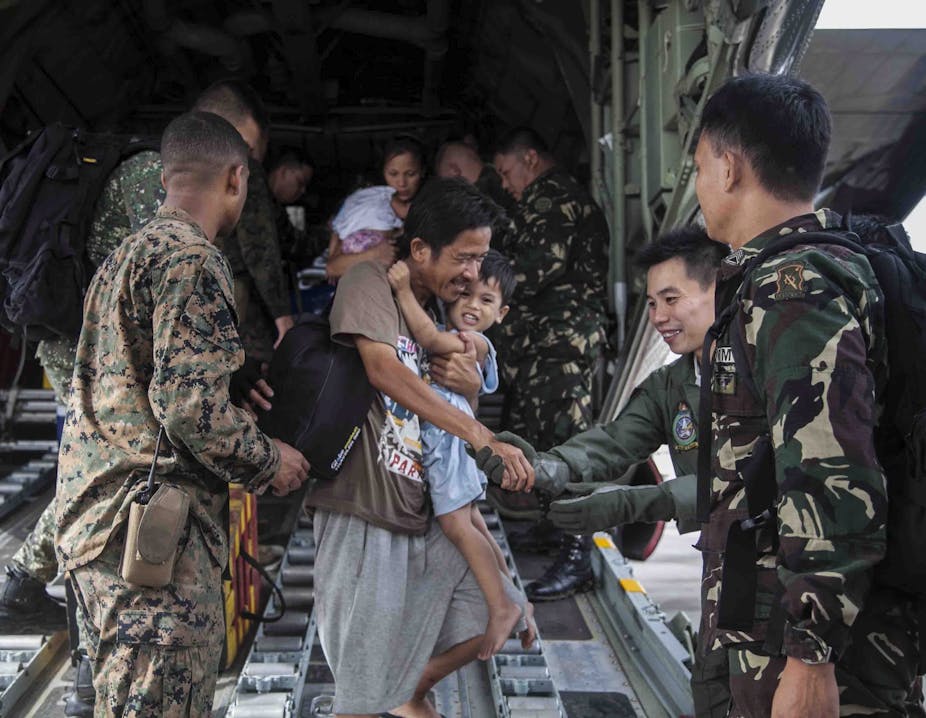Typhoon Haiyan, or Yolanda as it’s known in the Philippines, completely devastated parts of eastern Visayas in the central Philippines in a matter of hours. More than 4.2 million people have been affected across 36 provinces. 4500 are confirmed dead at time of publication with many unaccounted for. An estimated 670,000 people are displaced.
As the true extent of the devastation emerges, the international community has rallied to help. So far Australia had pledged A$30 million; the UK £10m million; the European Union €10 million; Japan $10 million and 25 emergency medical personnel; New Zealand NZ$2.15 million; and $100,000 each from Taiwan and Vietnam. China upped its initial $100,000 commitment with an additional A$1.75 million of relief supplies.
Only Australia rivals the United States’ response. On November 11, following a request from the Philippines government, US Defense Secretary Chuck Hagel ordered the nuclear-powered aircraft carrier USS George Washington – in Hong Kong for a port visit – and several other US Navy ships “to make best speed for the Republic of the Philippines” to provide humanitarian assistance and disaster support.
The initial focus of the US military-led relief effort includes surface and airborne maritime search and rescue, medium-heavy helicopter lift support and several aircraft with vertical takeoff and landing capabilities designed to operate in harsh environments. It also includes 307 members of the 3rd Marine Expeditionary Brigade deployed from Marine Corps Air Station, Futenma, Japan.
The US is also giving US$20m through USAID.

The Philippines is one of the United States’ six allies in the Asia-Pacific, along with Australia, Japan, Singapore, South Korea and Thailand. The sheer magnitude of the military-led US response to the crisis leaves no ambiguity about the significance America places on these strategic regional alliances.
During Hagel’s visit to the Philippines in August, he said:
Our close ties to the Philippines have been forged through a history of shared sacrifice and common purpose, and continuing to strengthen the close partnership between our nations is an important part of America’s long-term strategy of rebalancing in the Asia-Pacific.
The US is currently negotiating an agreement allowing it to position military equipment and rotate more personnel into the Philippines, while avoiding the contentious issue of re-establishing American bases in the country.
This comes amid growing tensions between the Philippines and China over areas in the South China Sea claimed by both countries and moves by the United States to ensure it retains influence in the region as China’s grows.
On November 7, Navy Admiral Samuel J. Locklear III, commander of USPACOM (the US Pacific Command), said that as part of its extensive regional engagement, the United States was looking for access that would enable it to help the Philippines in its defence as well as to aid in responding to disasters.
Locklear, who was responding to questions at a news conference, reiterated that America would not reopen bases in the Philippines. The arrangement under current negotiation, however, would allow US forces to visit for longer periods and be stationed on Philippine military bases.

The US has already used its former naval base in Subic Bay, a special economic zone in the Philippines catering to private investors for ship visits. Last year a subsidiary of the US defense contractor Huntington Ingalls Industries set up an operation to service US Navy nuclear powered ships, suggesting that the American presence in the area would grow.
The US Navy rotational presence is likely to follow the model used in the southern Philippines by the Joint Special Operations Task Force Philippines, comprising about 500 US military personal specialising on counter-terrorism. This was officially considered temporary but has been in operation since 2002.
And in moves likely to unnerve China, the Philippines is constructing a naval port in Oyster Bay’s cove, a deep natural harbour that opens directly on the South China Sea only a short distance from the contested Spratly Islands. The US is also planning to build advance command posts nearby on Palawan to monitor the South China Sea.
In the midst of this humanitarian tragedy, Typhoon Haiyan has delivered the means for the US to show solidarity to its Pacific ally. It has also allowed the US to send a clear message to China that it has the muscle needed to intervene at short notice in the region to protect its national interest if it feels it necessary.

